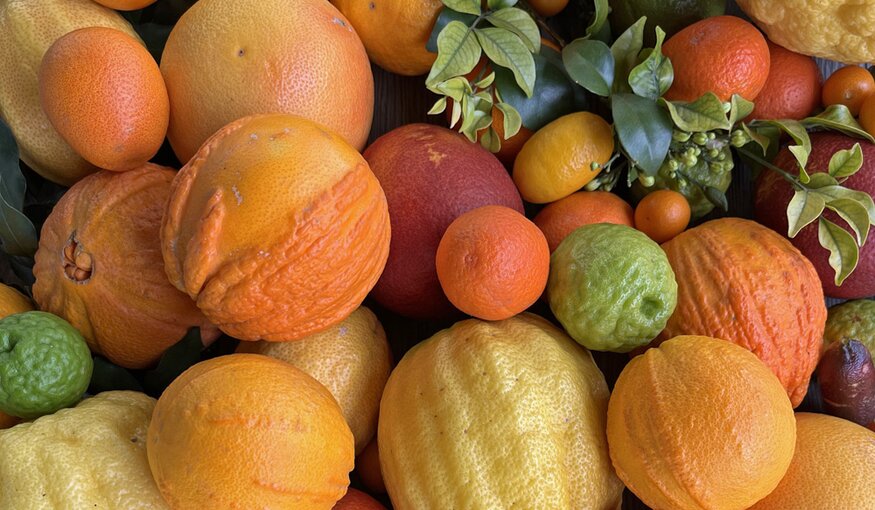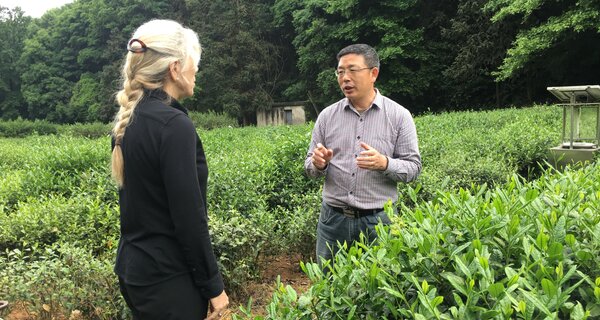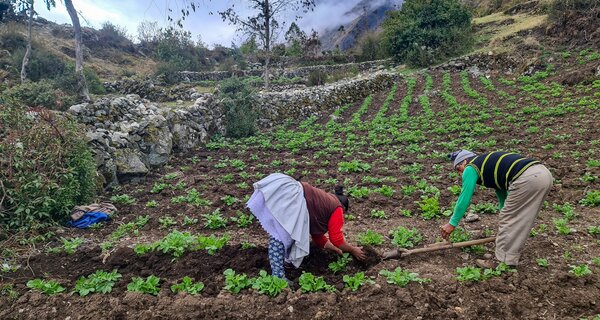If Life Gives You Lemons ...

Citrus diversity. Photo: T Siebert-Wooldridge and K Trunnelle, UC Riverside
21 August 2023
Many people will be familiar with the old adage, “If life gives you lemons, make lemonade.” But life did not give us lemons. The lemon is not a naturally occurring fruit, but a cross between a sour orange and a citron. And a sour orange is itself a cross between a pummelo and a mandarin.
Citrus crops — including oranges, lemons, limes, grapefruits and mandarins — are among the best-loved and most widely grown fruit crops globally: citrus orchards are found in more than 100 countries throughout subtropical, semi-tropical and tropical zones in both the northern and the southern hemisphere. Oranges account for nearly half the total global citrus production, at nearly 76 million tonnes in 2021, according to FAOStat.
The wild species that our modern citrus crops derive from — citron (Citrus medica), mandarin (C. reticulata), pummelo (C. maxima), makrut lime (C. hystrix) and papeda (C. micrantha), among others — are native to southern China, India and other regions of Southeast Asia.
Diversity Under Threat
But as with all crop diversity, citrus crops and their wild relatives are under threat from the effects of climate change, as well as from the emergence and spread of new pests and diseases, changes in land use such as deforestation, and increasing commercial focus on a limited range of cultivars. A bacterial disease, Huanglongbing or citrus greening disease, for example, poses an existential threat to commercial cultivation of citrus species and to the crops’ wild relatives.
Conserving and making citrus diversity available is essential to support breeding programs that seek to develop cultivars that can grow well in challenging conditions and meet the quality demands of consumers.
Urgent Need for Global Strategy
To support citrus conservation efforts around the world, in 2021 the Crop Trust and its partners conducted a survey of citrus genebank collections as part of a German-Government-funded project, “Breathing New Life into Global Crop Conservation Strategies.”
This survey identified 33 genebank collections conserving nearly 16,000 accessions of Citrus species. This is more than twice as many accessions as are registered in the Food and Agriculture Organization of the United Nation’s World Information and Early Warning System on Plant Genetic Resources for Food and Agriculture (WIEWS) and more than four times as many as are registered in the Genesys database.
“This is good news from the point of view of conservation,” said Gayle Volk from the United States Department of Agriculture (USDA) National Laboratory for Genetic Resources Preservation, lead author of A Global Strategy for the Conservation and Use of Citrus Genetic Resources.
One big concern, however, is that few of the collections are backed up at a second location, although many of the about 1,500 accessions managed by the USDA Agricultural Research Services in screenhouses are also being cryopreserved as shoot tips in liquid nitrogen.
Priority Actions Identified
The strategy identifies several priority actions needed to strengthen the conservation of citrus diversity.
The first of these is to improve the cataloging and sharing of information on citrus diversity. “This would go a long way to enhancing availability and use of the diversity currently held by the different genebanks,” said Volk. It would also contribute to promoting and supporting data collection and documentation efforts.
Building on the shared data, the collections would be able to identify gaps and overlaps in their collections. Gaps could then be filled through targeted collecting efforts and exchange of germplasm between the collections. And overlaps minimized to save resources.
Exchange of germplasm would also be greatly facilitated by enhancing health monitoring and controls on the collections.
As a long-term goal, the strategy recommends establishing a secure, internationally governed, global citrus collection that could develop, maintain and distribute pest- and disease-free citrus materials. This would boost use of the citrus diversity and reduce the risks of transmitting diseases along with planting materials.
Secure into the Future
Whether it is the lemon in your gin and tonic or the freshly squeezed orange juice with your breakfast, the new citrus strategy will contribute to ensuring these will be available whatever the future throws at us.
Categories: Global Crop Conservation Strategies, Citrus
About the Global Crop Conservation Strategy project
The development of this Global Crop Conservation Strategy was funded by the German Federal Ministry of Food and Agriculture (BMEL) as part of a three-year project led by the Crop Trust: “Breathing New Life into the Global Crop Conservation Strategies: Providing an Evidence Base for the Global System of Ex situ Conservation of Crop Diversity.”




